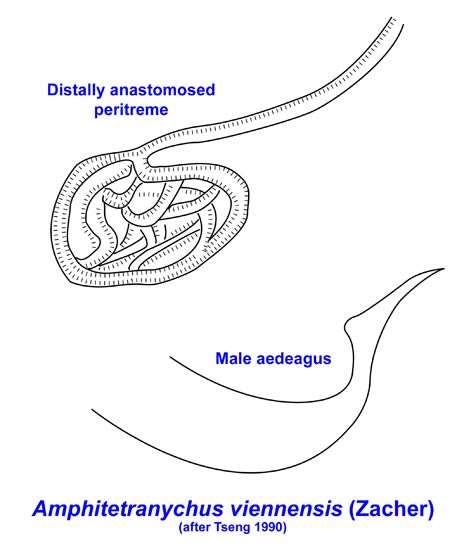Amphitetranychus
Superfamily Tetranychoidea
Family Tetranychidae
Subfamily Tetranychinae
Tribe Tetranychini
Genus Amphitetranychus
Common names: Fruittree spider mite, Hawthorn spider mite, Red spider mite
Probability of Encounter: High
Quarantine importance: Very high. The genus Amphitetranychus consists of only 3 described species, all of which were originally described as species of Tetranychus and all of which infest woody dicots. A. quercivorous (Eharah & Gotoh) and A. savenkoe (Reck) feed on oaks in Japan and Russia, respectively. The remaining species, however, the Fruittree spider mite A. viennensis (Zaqcher) is a significant pest of a variety of fruit trees and ornamentals and of especial concern to quarantine in the USA.
-
Hawthorn spider mite or Fruittree spider mite - Amphitetranychus viennensis (Zacher) (= Tetranychus viennensis Zacher, T. crataegi Hirst, Apotetranychus longipenis Ugarov & Nikolskii) attacks apple, apricot, most cherries, peach pear, logan berry, hazel nut, and a variety of ornamentals including poppy, crab apple, oak, and ash in Europe, Turkey, mainland Asia, and Japan.
Diagnosis:
-
With 1 pair of paranal setae (h3); setae h2 terminal.
-
Empodium split distally into 3 pairs of hairs.
-
Empodial spur absent.
-
Peritremes anastomosed distally.

Similar taxa. The empodia have tenent hairs in the Bryobiinae. Eutetranychini (e.g. species of Eutetranychus) have a claw-like or highly regressed empodium. Other Tetranychini have either 2 pairs of paranal setae (e.g. Allonychus, Panonychus) or have hooked empodia with proximoventral hairs and the duplex setae of tarsus I distal and adjacent (e.g. Oligonychus) or have an empodial spur and have peritremes recurved distally (Tetranychus).
References
Baker EW & AE Pritchard. 1960. The tetranychoid mites of Africa. Hilgardia 29(11): 455-574.
Baker EW & DM Tuttle. 1994. A guide to the spider mites (Tetranychidae) of the United States. Indira Pub. House, West Bloomfield, MI: 347 pp.
Beard JJ, Walter DE, & Allsopp P. 2003. Spider Mites of Sugarcane in Australia: A Review of Grass-feeding Oligonychus Berlese (Acari: Prostigmata: Tetranychidae) with the description of four new species. Australian Journal of Entomology 42: 51-78.
Bolland HR, J Gutierre & CHW Flechtmann. 1998. World Catalogue of the Spider Mite Family (Acari: Tetranychidae). Brill: Leiden.
Helle W & MW Sabelis (eds.) 1985. Spider Mites, Their Biology, Natural Enemies, and Control, vol. 1A. Elsevier: New York.
Jeppson LR, HH Keifer & EW Baker. 1975. Mites Injurious to Economic Plants, University of California Press: Berkeley
Meyer, M.K.P. 1974. A revision of the Tetranychidae of Africa (Acari) with a key to the genera of the world. Dept. Agr. Tech. Serv. Mem. 36: 291 pp.
Meyer, M.K.P. Smith 1987. African Tetranychidae (Acari: Prostigmata) - with reference to the world genera. S. Afr. Dept. Agr. Water Supply, Entomol. Mem. No. 69: 175 pp.
Navajas M, J Gutierrez & T Gotoh 1997. Convergence of molecular and morphological data reveals phylogenetic information in Tetranychus species and allows the restoration of the genus Amphitetranychus (Acari: Tetranychidae). Bull. Entomol. Res. 87: 283-288.
Navajas M, J Gutierrez, J Lagnel, G Fauvel, T Gotoh 1999. DNA sequences and cross-breeding experiments in the hawthorn spider mite Amphitetranychus viennensis reveal high genetic differentiation between Japanese and French populations. Entomologia-Experimentalis-et-Applicata. 1999 February; 90(2): 113-122
Ochoa R, H Aguilar & C Vargas 1994. Phytophagous Mites of Central America: An Illustrated Guide CATIE, Turrialba, Costa Rica.
Tseng Y-H 1990. A monograph of the mite family Tetranychidae (Acarina: Trombidiformes) from Taiwan. Taiwan Museum Special Publication series 9. 224 pp.
Zhang Z-Q. 2003. Mites of greenhouses: identification, biology and control. CABI Publishing, Wallingford: 244 pp.